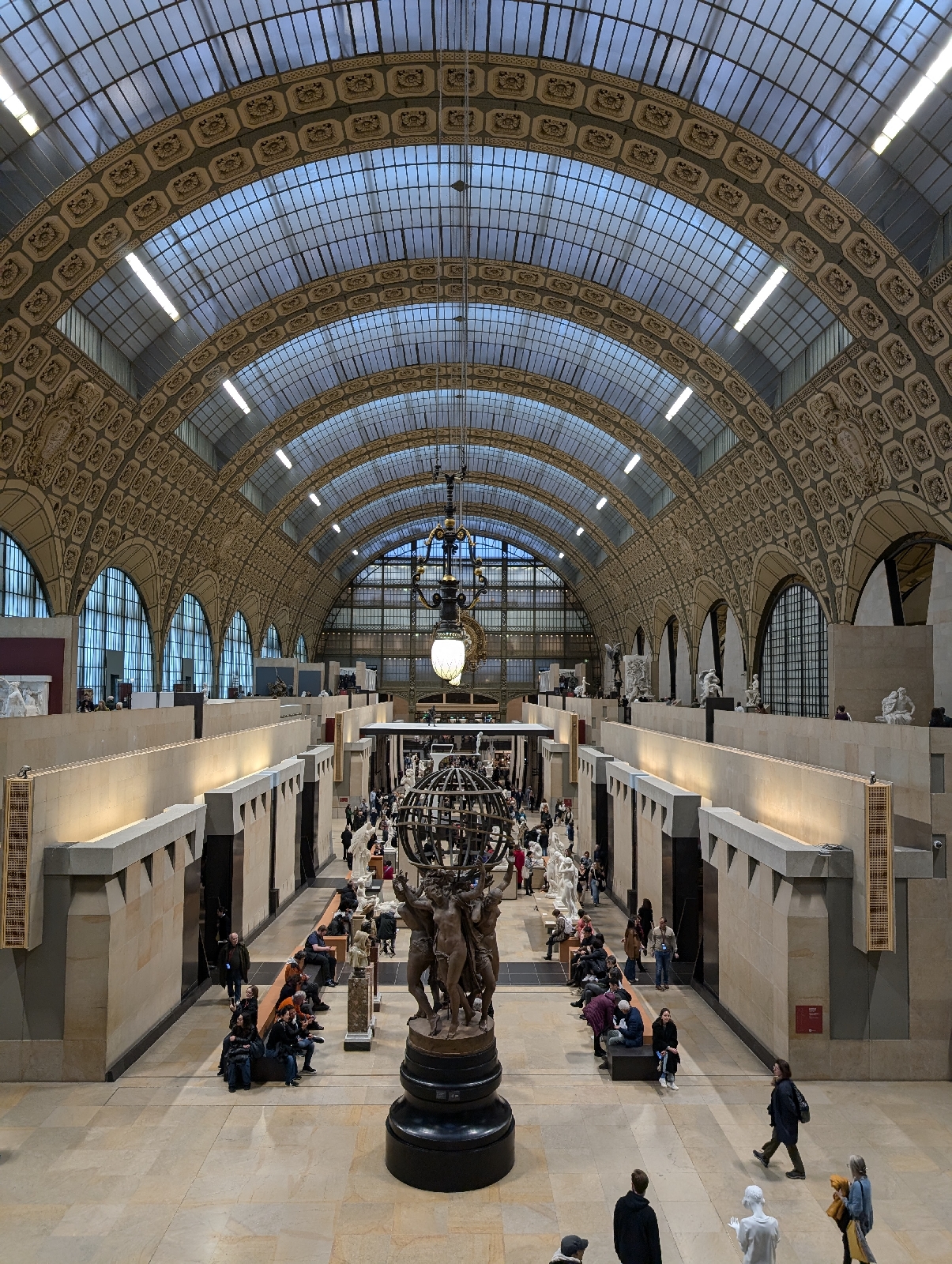Jeeves Hat
Journal on book reviews, art and film, hopefully travel, reflections on the real world (and perhaps some law).
Tuesday, November 19, 2024
Musée d'Orsay
Thursday, November 14, 2024
Heretic (2024) - film review
“Heretic” offers a novel and unsettling thriller/horror film that lingers with you after the film’s credits roll - religious themes in a twisted and suspenseful narrative.
It’s one of those films littered with subtle clues and signs.
Two young missionaries encounter a reclusive & mysterious Englishman (Hugh Grant) ... which sets the stage for an unsettling game of cat and mouse.
The first 3/4 of the film is great.
The tension gradually builds up and one is never fully sure of each character’s true rationale/motives. Are the missionaries really true believers? Is Mr Reed actually an OK guy? Hugh Grant is great at unsettling you with his raffish rogueish charm (masking his darker intent). He is engrossing & I enjoyed his deeper chronicling on the meta of religions. The other actors (Sophie Thatcher and Chloe East) are equally impressive.
The film’s darkened atmosphere & claustrophobia is masterful which magnifies the unease.
However, the final act, fails to satisfy.
I felt that the v. thought-provoking and unsettling commentary on evil & religion demanded a worthy and “extraordinary” denouement.
Yet, it seemed to me like something was missing.
Rating: 3 ★★★
Tuesday, November 12, 2024
The John Smyth scandal and Justin Welby
Another scandal in England ... and another leader claiming to have “known nothing about it” (à la Vennels at the Post Office).
Justin Welby - Archbishop of Canterbury and head of the Anglican Communion - is accused of having “most probably” known about the horrific & sadistic abuse meted out at the hands of the serial predator John Smyth. According to the report, it was “most probable”.
He spent some time (vague?) with Smyth in South Africa after he quickly disappeared from England. As far back as the 1970s and 1980s, people within the church are said to have known that Smyth was an abuser. Welby maintains that he wasn’t aware & sorry for the errors. Ultimately, though, the fault lies elsewhere.
Should he resign?
I’m not sure.
For yes = it would because of the Archbishop’s moral authority which may be forfeited if he stays on in Lambeth Palace. It would be about the broader CofE’s safeguarding procedures. After all, Welby appears to have done nothing even in 2013 when he was alerted (presumably call the police?).
For no = on the other hand, the report says that 40 years ago Welby was in a professional/social circle in which he might have been exposed to information that someone else was behaving in a v. concerning manner. It doesn’t seem just to punish him for something he may not have been responsible for. It seems merely being alive in the 80s was enough for a moral failing. It is hard to say if Welby, personally, covered up the abuse, or ignored it.
Not sure.
The Lord Mayor’s Show procession
Hello bloggers!
I was at St Paul’s Cathedral for the 2024 Lord Mayor Show.
The Lord Mayor’s Show goes back to the early 13th century.
King John granted that the City of London could appoint its own Mayor — but insisted that each newly-elected Mayor come upriver to Westminster to swear loyalty to the Crown.
Lord Mayors of London have been making that journey for over 800 years.
Sunday, November 10, 2024
Amsterdam violence against Israeli football fans
Infuriating scenes in Amsterdam. They make my blood boil. Feels like Europe 1939!
Mobs waiting for Jews. There was a video of some guy begging for his life and offering the assailants his wallet and possessions while they kick him to the ground, or the video of the mob chasing down and beating a Jew in broad daylight, or the video of the lynch mob demanding to see a man’s passport as to whether he is Jewish or not so they know whether to beat him up. Or being forced to jump into canals to save themselves.
Over 60 arrests, and Jews were even told to shelter in places to be safely evacuated.
The Dutch PM has already condemned this as a deliberate antisemitic attack.
✲✲✲
Some people may say that the Israeli football fans “antagonised” people with their shouting and tearing down flags etc. However, no amount of stupid, angry, or disrespectful chants (or bad behaviour) justifies beating-up anyone from that country that we can find, and throwing them into the river etc.
What happened cannot be attributed to everyday hooliganism.
It was open violence against Jews & Israelis.
Thursday, November 7, 2024
President Trump’s election victory
Wow. Trump has done it again.
An incredible political comeback. I gotta say ... my hat’s off to him.
The Trump trifecta! ... The Executive, the Senate and perhaps the House. He even won the popular vote.
He will definitely go into the history books. I can’t think of anyone - wealthy, famous or both - who has his guts and doesn’t just quit.
✲✲✲
Why did Harris lose?
Apart from Trump’s zealous base, I don't think that this was a vote for Trump — rather a vote against Obama/Biden/Harris than anything else.
Some of the defeat must be laid at the feet of the Democratic establishment; but Harris is really the beau idéal of “identity politics” and Obama’s “progressivism” legacy.
Why was it a resounding defeat for Harris?
- The party’s obsession with identity politics - The overt racial pandering exhibited during Biden’s term, incl. discriminatory covid relief in the name of “equity”, was deeply off-putting to ordinary everyday Americans. Also things like defunding police, cashless bail etc. Then, there’s fear of the Party’s radical base: such as Harris passing over Josh Shapiro (the v. popular governor of Pennsylvania) as VP. His Jewishness and vocal support for Israel were probably unpalatable to the extreme left among the Dems. The obsession with gender issues, e.g. forcing girls to share locker-rooms with 180-pound bearded males angling to make a point. The seeming indifference to the victims of illegal migrant crimes etc.
- Harris is a bad candidate and a product of “identity politics” - Harris was an offspring of Biden. Produced by Jim Clyburn’s tilting of the 2020 South Carolina Democrat primary away from Bernie Sanders by telling the “black bloc” to vote for Joe. And, as for political acumen, when asked if there was anything she would change from Biden, she could think of nothing?!
- Biden stepped down late & immediately anointed Kamala Harris - Surely at least a 3-4 week search for other candidates. Even Obama wanted a DNC without Kamala as “the” candidate. I suspect that there was no way of sidestepping Harris without incurring the wrath of progressive women and blacks.
- Democrats hiding Biden’s mental decline - The Dems imagined no-one would notice a brain-dead President.
- Reductio ad Hitlerum - People who compares Trump to Hitler/Mussolini can’t be taken seriously v. seriously. It’s the repurposing of historical events to try and fit them into modern day narratives, and it just doesn’t really work as far as understanding Trump. It diminishes credibility and the legitimate criticisms against Trump.
- Lawfare Pursuit of Trump - Trump’s enemies insisted on making the news cycle revolve around him from the day he left office. They kept him in the public eye giving credence to his underdog status, fighting the “corrupt establishment”.
Wednesday, November 6, 2024
Spanish King Felipe showing courage and accountability
V. shocked to see protesters and flood survivors throwing mud & rocks at King Felipe VI.
They shouted insults at him when he visited their devastated town. V. sad & tragic.
But it’s also shameful of these Spaniards to behave like this.
The people should be furious with the president of the Valencian government (Mazón) and the National President (Pedro Sánchez). It seems the regional government was informed of the flooding danger in the early morning, but refused to act until the flooding had already been going for a while. And ... then Mazón denies help from firefighters and rescue teams from other parts of Spain. He also refuses to call in the Army. Incredible incompetence. State of emergency should have been declared so the military could act much quicker and at full force. It’s been 5 days with little aid & only 1200 military for a flooding that affected 450k citizens.
The King came to speak to the people — while the other two hid in their armored cars.
Respect the king.
Spain is a constitutional monarchy. The King - as Head of State - has no actual power. He can only seek to sway the government.
And yet, he actually faced people ... so he genuinely cares.
Tuesday, November 5, 2024
November 5 US election bet - Harris will win
I think Harris is going to win.
I think it seems to lean her way, women will turn out for her, and abortion is a big issue.
Trump’s polling bumped up briefly following the assassination attempt, but that didn’t translate into any sustained enthusiasm. Moreover, from what I’ve seen, the number of Republicans who will definitely vote for him has declined over the last two months. This is because people who like Trump tend to love him — but right-leaning voters (that don’t love him) tend to be turned off by him. His path to victory relies on a surge of Republican turnout across the board; and I don't think he can generate it.
Perhaps even more importantly, I think the January 6th insurrection was a serious scandal which left many voters with existential worries concerning Trump being in power again. Its aftermath has motivated voters against him & caused many more moderate right-leaning voters to sit this election out.
Harris is dreadful ... Trump is terrible.
What a choice!
Kemi Badenoch - new leader of Conservative Party
The leader of HM Official Opposition has been elected.
The Tories have their 4th woman leading them.
Culture wars
On the first issue, the culture wars seep into the fabric of our nation. I think patriotic pride (in our nation, our imperial history, our Royal Family) along with the need for a strong defence and secure borders are the foundations of Conservatism. It’s about being proud of the journey and progression of our small island, and the number of times we lead the way for other nations around the world.
Our culture defines our broader shared system of values. Their defence should be the basis for uniting the Right against the endless left-wing “identity politics” rhetoric and its stranglehold over the public sector. Britain has an incredible history. We shaped the world. There is no squeaky-clean spotless national history. But, if one adopts a measured perspective of both good and bad, I think we should be proud as a force for good in the world.
Immigration
On immigration, the huge levels of immigration really worry me. A shared identity and values and the feeling that we’re looking out for each other’s interests is important. For some time, I’ve had the feeling we’re unravelling into a miscellany of various tribal interests.
We’ve also rarely had a sensible conversation on the issue — and that’s because of the “omg that’s racist!” crowd derailing its every opportunity.
I preferred Jenrick on this issue. I like his tougher approach to the huge mass immigration problem, including withdrawing from the Convention on Human Rights, which was a centrepiece of his leadership campaign. He was a breath of fresh air. Mrs Badenoch served in senior positions in two v. unconservative governments.
I’m not sure whether she can deal with the massive immigration problem.
And that alone gives Reform all the space it needs to occupy the centre-right.


